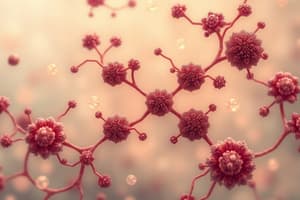Podcast
Questions and Answers
What is the primary function of drug metabolism in the body?
What is the primary function of drug metabolism in the body?
- To enhance the drug's potency
- To increase the drug's binding affinity to proteins
- To prolong the drug's active duration
- To make the drug easier to excrete (correct)
Which type of drugs are most likely to remain sequestered in the plasma due to their properties?
Which type of drugs are most likely to remain sequestered in the plasma due to their properties?
- Small lipophilic drugs
- Large hydrophobic drugs
- Protein-bound drugs (correct)
- Hydrophilic drugs
Where is the primary site of drug metabolism in the body?
Where is the primary site of drug metabolism in the body?
- Kidneys
- Intestinal lining
- Lungs
- Liver (correct)
What role do plasma or tissue proteins play in drug binding?
What role do plasma or tissue proteins play in drug binding?
Which of the following statements about drug characteristics and their distribution is true?
Which of the following statements about drug characteristics and their distribution is true?
What is the primary cause of differences in drug absorption rates among individuals?
What is the primary cause of differences in drug absorption rates among individuals?
In pharmacokinetics, which term best describes the time it takes for the plasma concentration of a drug to reduce by half?
In pharmacokinetics, which term best describes the time it takes for the plasma concentration of a drug to reduce by half?
What factor can significantly impact the distribution of a drug within the body?
What factor can significantly impact the distribution of a drug within the body?
Which phase of drug metabolism primarily involves the modification of drug structure to facilitate excretion?
Which phase of drug metabolism primarily involves the modification of drug structure to facilitate excretion?
Which dosing strategy is primarily used to quickly achieve a therapeutic concentration of a drug in system circulation?
Which dosing strategy is primarily used to quickly achieve a therapeutic concentration of a drug in system circulation?
What is the primary challenge of achieving ideal total body clearance for a drug?
What is the primary challenge of achieving ideal total body clearance for a drug?
What describes the therapeutic window of a drug?
What describes the therapeutic window of a drug?
Which of the following drug delivery methods is designed to bypass the acidic environment of the stomach?
Which of the following drug delivery methods is designed to bypass the acidic environment of the stomach?
What is the primary mechanism by which water-soluble drugs cross cell membranes?
What is the primary mechanism by which water-soluble drugs cross cell membranes?
Which of the following factors directly influences the rate of drug absorption in the gastrointestinal tract?
Which of the following factors directly influences the rate of drug absorption in the gastrointestinal tract?
Which type of membrane transport requires energy and can be saturated?
Which type of membrane transport requires energy and can be saturated?
Which of these is NOT a factor influencing drug absorption?
Which of these is NOT a factor influencing drug absorption?
Which of the following statements about P-glycoprotein is TRUE?
Which of the following statements about P-glycoprotein is TRUE?
Which transport mechanism is most likely to be involved in the absorption of very large drug molecules?
Which transport mechanism is most likely to be involved in the absorption of very large drug molecules?
Which of the following is a key factor that determines the rate of absorption of a drug through passive diffusion?
Which of the following is a key factor that determines the rate of absorption of a drug through passive diffusion?
What is the primary difference between facilitated diffusion and active transport?
What is the primary difference between facilitated diffusion and active transport?
Which of these factors would likely increase the rate of absorption of a lipid-soluble drug?
Which of these factors would likely increase the rate of absorption of a lipid-soluble drug?
What is the primary role of absorption in pharmacokinetics?
What is the primary role of absorption in pharmacokinetics?
Which factor does NOT affect the distribution of a drug in the body?
Which factor does NOT affect the distribution of a drug in the body?
What characterizes the metabolism of a drug?
What characterizes the metabolism of a drug?
In the context of elimination, which statement is true?
In the context of elimination, which statement is true?
Which route of administration would likely yield the fastest absorption of a drug?
Which route of administration would likely yield the fastest absorption of a drug?
What type of formulation typically involves a drug that is absorbed when melted at body temperature?
What type of formulation typically involves a drug that is absorbed when melted at body temperature?
Which factor affects drug distribution to tissues the least?
Which factor affects drug distribution to tissues the least?
Which liquid formulation is NOT commonly used for medicinal purposes?
Which liquid formulation is NOT commonly used for medicinal purposes?
What term describes the process by which drugs are removed from the body?
What term describes the process by which drugs are removed from the body?
What is the primary characteristic of continuous infusion regarding its administration?
What is the primary characteristic of continuous infusion regarding its administration?
Which of the following statements about intermittent infusion is correct?
Which of the following statements about intermittent infusion is correct?
What distinguishes a rapid bolus dose from other types of dosing?
What distinguishes a rapid bolus dose from other types of dosing?
Which of the following is NOT a route of administration for nebulized medication?
Which of the following is NOT a route of administration for nebulized medication?
How is a slow bolus dose characterized in its administration?
How is a slow bolus dose characterized in its administration?
What is the significance of enteral route absorption?
What is the significance of enteral route absorption?
Which administration method is used for administering medication at 75 mL/h IV?
Which administration method is used for administering medication at 75 mL/h IV?
What does the term 'loading dose' refer to in IV dosing?
What does the term 'loading dose' refer to in IV dosing?
What is a common characteristic of oral dosing as compared to intravenous dosing?
What is a common characteristic of oral dosing as compared to intravenous dosing?
What is an important consideration when understanding 'beer before liquor, never sicker' in relation to therapeutic dosing?
What is an important consideration when understanding 'beer before liquor, never sicker' in relation to therapeutic dosing?
Flashcards
Pharmacokinetics
Pharmacokinetics
The study of how the body absorbs, distributes, metabolizes, and eliminates drugs.
Absorption
Absorption
The process by which a drug enters the bloodstream from its administration site.
Distribution
Distribution
The distribution of a drug throughout the body to reach its target sites.
Metabolism
Metabolism
Signup and view all the flashcards
Elimination
Elimination
Signup and view all the flashcards
Half-Life
Half-Life
Signup and view all the flashcards
Total Body Clearance
Total Body Clearance
Signup and view all the flashcards
Solution
Solution
Signup and view all the flashcards
Powder
Powder
Signup and view all the flashcards
Suppository
Suppository
Signup and view all the flashcards
Inhalant
Inhalant
Signup and view all the flashcards
Drug Absorption
Drug Absorption
Signup and view all the flashcards
Drug Distribution
Drug Distribution
Signup and view all the flashcards
Drug Metabolism
Drug Metabolism
Signup and view all the flashcards
Drug Elimination
Drug Elimination
Signup and view all the flashcards
Drug Half-Life
Drug Half-Life
Signup and view all the flashcards
Enteric-Coated Pills
Enteric-Coated Pills
Signup and view all the flashcards
Extended-Release Pills
Extended-Release Pills
Signup and view all the flashcards
Passive Diffusion
Passive Diffusion
Signup and view all the flashcards
Facilitated Diffusion
Facilitated Diffusion
Signup and view all the flashcards
Rapid Bolus Dose
Rapid Bolus Dose
Signup and view all the flashcards
Slow Bolus Dose
Slow Bolus Dose
Signup and view all the flashcards
Intermittent Infusion
Intermittent Infusion
Signup and view all the flashcards
Continuous Infusion
Continuous Infusion
Signup and view all the flashcards
Intravenous (IV) Dosing
Intravenous (IV) Dosing
Signup and view all the flashcards
Oral Dosing
Oral Dosing
Signup and view all the flashcards
Loading Dose
Loading Dose
Signup and view all the flashcards
Enteral Route
Enteral Route
Signup and view all the flashcards
Therapeutic Dosing
Therapeutic Dosing
Signup and view all the flashcards
Drug Dosing
Drug Dosing
Signup and view all the flashcards
What is drug metabolism?
What is drug metabolism?
Signup and view all the flashcards
Where does drug metabolism primarily happen?
Where does drug metabolism primarily happen?
Signup and view all the flashcards
How does drug binding to proteins affect its action?
How does drug binding to proteins affect its action?
Signup and view all the flashcards
What does lipophilicity mean for a drug's action?
What does lipophilicity mean for a drug's action?
Signup and view all the flashcards
Explain how drug distribution works within the body.
Explain how drug distribution works within the body.
Signup and view all the flashcards
Study Notes
Pharmacokinetics
- Pharmacokinetics is the study of how drugs move through the body
- Includes absorption, distribution, metabolism, and elimination
- Key concepts include:
- routes of drug administration (enteral, parenteral, etc.)
- drug formulations (liquids, solids, suppositories, inhalants, etc.)
- absorption processes (passive diffusion, facilitated diffusion, active transport, etc.)
- factors affecting absorption (pH, blood flow, surface area, contact time, P-glycoprotein)
- distribution (blood flow, capillary permeability, drug binding to proteins, lipophilicity, volume of distribution)
- metabolism (sites, factors affecting metabolism, first-order and zero-order kinetics, Phase I and II of metabolism, the cytochrome oxidase system)
- elimination (sites, factors affecting elimination, renal clearance, forms of oral and IV administration, considerations for dosing and dosing intervals, therapeutic dosing goals and considerations)
- drug dosing (continuous infusion, intermittent infusion, slow bolus dose, rapid bolus dose, oral, IV)
Absorption
- Absorption is the process by which a drug moves from its site of administration into the bloodstream
- Factors affecting absorption: pH, blood flow, surface area, contact time, P-glycoprotein
- Drug formulations impact absorption rates
- Different forms of drug formulations are absorbed differently, some are faster than others
Distribution
- Distribution describes the movement of a drug to and from the bloodstream and tissues
- Factors affecting distribution: blood flow, capillary permeability, drug binding to proteins, lipophilicity, volume of distribution
- Half-life is the time it takes for the drug concentration to be reduced by 50% in the body
Metabolism
- Metabolism is the chemical alteration of a drug by the body to make it easier for the body to process and excrete.
- Metabolism is an important aspect of pharmacokinetics as it helps us to understand how drug concentration changes over time
- Factors affecting metabolism: individual genetics, co-morbidities (e.g., hepatic, renal, cardiac diseases), co-ingestion, and chronic ingestion
- There are two major phases of metabolism: Phase I and Phase II reactions that render drugs inactive
- These reactions often convert lipophilic drugs to more water-soluble forms which are more easily eliminated
- Enzyme activity plays a key role in drug metabolism
Elimination
- Elimination is the removal of a drug or drug metabolite from the body
- The primary organ for drug elimination is the kidneys
- Renal clearance is the sum of all clearances by drug-metabolizing and drug-eliminating organs, including the liver and other tissues
- Factors affecting elimination: rate of drug metabolism, renal and hepatic blood flow, kidney function
- Glomerular filtration is an important step in renal clearance
- Passive and Active diffusion affect the elimination of drugs
Dosing
- Various drug administration methods include continuous infusion, intermittent infusion, slow bolus dose, and rapid bolus dose, all with specific considerations for timing
- Considerations for dosing procedures involve drug concentration, half-life, therapeutic window and adverse effects
- Patient assessments help in ensuring the right treatment and proper dose
Other Key Info from the document
- Review assigned chapters on Brightspace for pharmacokinetics
- Complete Nearpod exercises (links on Brightspace)
- Consider the optional handwritten tutorials on pharmacokinetics
- Introduction, Absorption, Distribution, Metabolism, and Excretion
- Understand different drug formulations
- Be familiar with routes of administration (enteral, parenteral, etc.) & their impact on drug delivery and absorption
- Identify factors affecting each stage of pharmacokinetics and how they can influence drug action
- Be familiar with the terms and concepts related to the different phases of drug metabolism and kinetics
Studying That Suits You
Use AI to generate personalized quizzes and flashcards to suit your learning preferences.




